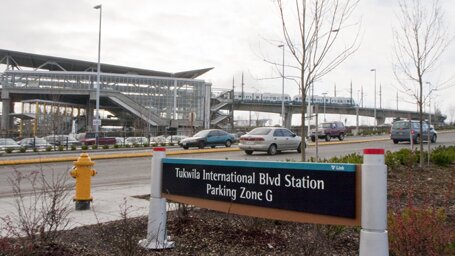
Sound Transit is kicking the tires on a plan to charge a fee of some kind–daily or monthly–to commuters using its park-and-ride lots, reports Mike Lindblom in the Seattle Times. Partly the idea is to make sure that commuters are using the lots, not people ducking in for free parking. (It’s rumored that some percentage of Tukwila International Boulevard Station’s 600 parking spaces are being used as airport parking, for instance.)
That’s an easy enough fix: “One idea is to have everyone pay, then give train riders a partial rebate when they tap the ORCA fare card in the station,” writes Lindblom. Of course, if one agency starts, then others would presumably follow. Lindblom notes that King County Metro’s park-and-ride lots at White Center, Northgate, South Bellevue, South Kirkland, Bear Creek, and Redmond are equally jam-packed.
The idea puts some Seattle Times commenters ranters in a tight spot, where they have to portray this eminently capitalist solution to a supply-and-demand problem as “socialist” because it is being thought of by a transit agency. (The reverse is clearly true: Free parking is the socialism everyone loves.) But at first glance, it seems like this might hurt transit ridership, and wouldn’t that be a problem? Writes one commenter:
If you add a parking charge on top of the transit pass cost, it becomes cheaper to just drive downtown…and those cars go straight back to the highway.
Well, no. Right now there is excess demand for park-and-ride spaces, which means that, already, cars are being driven into town by frustrated commuters, after trawling the lot. Given the fixed amount of park-and-ride spaces available, there is a price at which they will still fill up, and the much larger pool of potential parkers will still be out of luck. If Sound Transit were to set too high a price, all that’s needed is to lower it until the lots are full again.
UPDATE: A commenter on this site responds to the “cheaper to drive downtown” hypothesis:
The lot across from my office is $19/day. Compare that with my employer-paid Orca card and $2-5/day to park… How does that cost enough to put me back in traffic?
In fact, people are paying for the spaces already: with their time, since they’re arriving earlier to get a spot. When time is money, it’s only a matter of time until money can buy you time.
What’s eye-opening is the parking subsidy involved to begin with. Lindblom quotes a low, low average cost of $30,000 per parking space. If you charged $5 per day, you could pay that off in 16 years. At $2, 41 years. That cost soars if the space is in a parking garage, rather than a lot. (Over at the Seattle Transit Blog, a commenter questions those estimates as sounding on the high side.) Sound Transit says any fee would likely only cover ongoing lot maintenance, rather than help pay for construction.
So any hard-nosed economist would be hard-pressed not to recommend charging for park-and-ride spaces. Only getting the price wrong–and keeping it wrong–would effect transit ridership negatively. (A truly hard-nosed economist might question why, given the construction-cost asymmetry, you’ve built them in the first place rather than let private enterprise sort it out.) And at least in terms of light rail park-and-rides, there’s no way to match train capacity to parking spaces: Light rail stations are where they are because enough people can walk, bike, or bus to them, and that density means land is too scarce and thus too valuable to use as free parking.

“If you add a parking charge on top of the transit pass cost, it becomes cheaper to just drive downtown…and those cars go straight back to the highway.”
Really?
The lot across from my office is $19/day. Compare that with my employer-paid Orca card and $2-5/day to park… How does that cost enough to put me back in traffic?
Even if I paid my own fare,it’d still be cheaper. If you included mileage or gas/wear and tear on a vehicle, the balance would tip back into no-brainer territory.